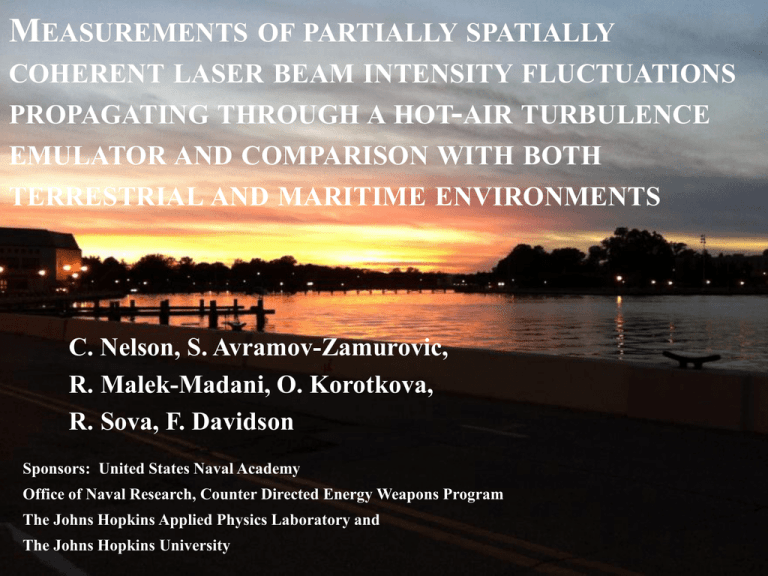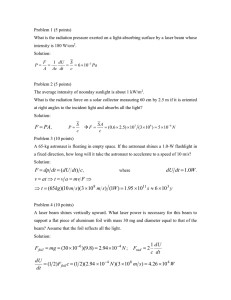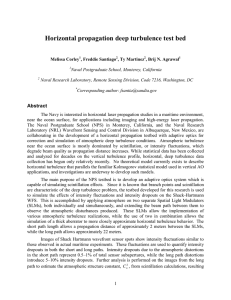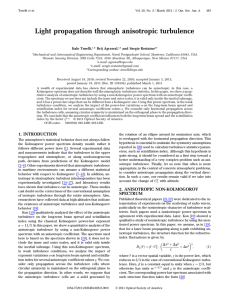M -
advertisement

MEASUREMENTS OF PARTIALLY SPATIALLY COHERENT LASER BEAM INTENSITY FLUCTUATIONS PROPAGATING THROUGH A HOT-AIR TURBULENCE EMULATOR AND COMPARISON WITH BOTH TERRESTRIAL AND MARITIME ENVIRONMENTS C. Nelson, S. Avramov-Zamurovic, R. Malek-Madani, O. Korotkova, R. Sova, F. Davidson Sponsors: United States Naval Academy Office of Naval Research, Counter Directed Energy Weapons Program The Johns Hopkins Applied Physics Laboratory and The Johns Hopkins University FIELD TESTS – OVERVIEW Field Tests at USNA 314 meter over water link, HeNe (632.8 nm) 180 meter terrestrial link, IR (1550 nm) PHASE SCREEN CONSTRUCTION Beam with specified coherence properties Spatial Light Modulator Phase Screens Black Coherent Less Strong Diffuser Strong Diffuser γφ2 = 16 Laser γφ2 = 1 Gaussian Schell Model beam generation SCINTILLATION INDEX – OVER WATER LINK SCINTILLATION INDEX – TERRESTRIAL LINK Turbulence Generator Mk I, Mod 0 Photo looking down through turbulence generator, daughter Aurora pictured INITIAL TURBULENCE EMULATOR THEORY High delta T High Cn2 Hot and cool air meet and mix Red Oak, aluminum flashing, modular RESULTS Heat On Heat Off Cn2 ~10-9 m-2/3, σI2 ~ 0.02 – 0.05, σR2 ~0.1 - 0.7 Initial design showed some positive results/proof of concept 2ND TURBULENCE EMULATOR MOD 0 TO THE MOD 1 TE COMPARISON WITH FIELD TESTS 1550 nm, 10 cm Tx, closed loop, AO, 10.7 km, Nf = 0.2 IR beam HeNe beam Fiber coll., 1550 nm, pol., exp., SLM, Mech. IRIS, Nf = 0.987 In laboratory TE set-up THEORY Gamma-Laguerre (GL) Medium and source independent Uses first n moments Gamma-Gamma (GG) Source, medium dependent Uses first two moments Lognormal (LN) Classical weak turbulence model Temporal Autocovariance Bx (t1 , t2 ) x(t1 ) x(t1 ) x(t2 ) x(t2 ) Bx ( ) Rx ( ) m 2 and Rx ( ) x(t1 ) x(t2 ) B(exp fit ) (tdata ) Ae ( tdata / T1 ) 𝜇= 𝐼 , 𝛽= 𝑊𝑛 = 𝑛! 𝛤(𝛽) 𝑊0 = 1, 𝑊1 = 𝑊2 = 0 𝐿𝑛 𝑊𝐺𝐺 𝐼 = 𝑊𝑔 𝐼 = 𝛼 +𝛽 2 1 𝛼= 2 𝜎𝑙𝑛𝑥 = exp 𝐼 2 𝜎𝑙𝑛𝑥 −1 𝐼 , 𝛽= 𝜗 = [1 + ( 𝐼2 − 𝐼 2𝐿 𝑘𝑊02 𝑛+𝛽−1 𝑛−1 𝛼 +𝛽 −1 2 [1+0.56 1+𝜗 𝜎𝐵2 = 2 −𝛽 /𝜇 𝑘 𝐼 𝑘 𝑛 𝑘=0 𝑘! 𝑛 −𝑘 !𝛤(𝛽 +𝑘), 0.49𝜎𝐵2 ,𝐼 ≥ 0 2 𝐼2 − 𝐼 𝑛 𝑘=0 𝛤 𝛼 𝛤 𝛽 𝑊𝐿𝑁 𝐼 = 𝐼𝜎 𝛤 𝛽 𝑥 = 2 𝛼𝛽 𝜇 𝛽 𝛽 𝛽 −1 𝛽𝐼 𝐼 exp (− ) 𝜇 𝜇 1 𝛽 −1 𝛽𝐼 𝛽 −1 ∞ 𝑛=0 𝑊𝑛 𝐿𝑛 𝑊𝐺𝐿 𝐼 = 𝑊𝑔 𝐼 2 (−𝑥 )𝑘 𝑘! 𝐾𝛼−𝛽 2 𝛼𝛽𝐼 , 𝐼 > 0 1 2 exp 𝜎𝑙𝑛𝑦 −1 12 𝜎𝐵5 ]7/6 2 𝑎𝑛𝑑 𝜎𝑙𝑛𝑦 = 0.51𝜎𝐵2 12 [1+0.69 1+𝜗 𝜎𝐵5 ]5/6 / 𝐼 2, )2 ]−1 1 2𝜋 𝑒𝑥𝑝 − 𝜇 = ln (𝐼) 𝜎 2 = 𝑣𝑎𝑟(ln 𝐼 ) ln 𝐼 −𝜇 2 2𝜎 2 ,𝐼 > 0 TE COMPARISON WITH OVER THE CREEK A: USNA, HeNe BLACK (COHERENT) B: TE, IR C: USNA, HeNe 16 (LESS COHERENT) D: TE, IR Case Nf DS/ρ0 σI2 T1 # Fades 80/100 Avail. A 0.1 0.2 0.012 6 294 7 to 22 ms 98.1% B 1.0 0.3 0.014 2 1622 2 to 9 ms 96.7% C 0.1 0.2 0.011 12.9 416 4 to 30 ms 98.7% D 1.0 0.3 0.010 2.6 1281 2 to 12 ms 97.5% TE COMPARISON WITH OVER THE CREEK T-Test p16 = 0.02, p4 = 0.22 CONCLUSIONS/DISCUSSION Possible scintillation index ‘sweet’ spot, that depends on range and atmospheric characteristics PDF and 2nd order temporal Autocovariance in combination can possibly provide important information about fade statistics – notably, that a shorter correlation time leads to a higher number, but shorter duration fades REFERENCES Mayer, K. J., Young, C. Y., “Effect of atmospheric spectrum models on scintillation in moderate turbulence,” J. Mod. Opt. 55, 1362-3044 (2008) [2] K. Drexler, M. Roggemann, D. Voelz, “Use of a partially coherent transmitter beam to improve the statistics of received power in a free-space optical communication system: theory and experimental results,” J. of Opt. Eng., 50(2), 025002, (2011). [3] C. Nelson, S. Avramov-Zamurovic, R. Malek-Madani, O. Korotkova, R. Sova, F. Davidson, "Measurements and comparison of the probability density and covariance functions of laser beam intensity fluctuations in a hot-air turbulence emulator with the maritime atmospheric environment," Proc. SPIE 8517, (2012) [4] O. Korotkova, S. Avramov-Zamurovic, R. Malek-Madani, and C. Nelson, “Probability density function of the intensity of a laser beam propagating in the maritime environment,” Optics Express. Vol. 19, No. 21, (2011) [5] Barakat, R., “First-order intensity and log-intensity probability density functions of light scattered by the turbulent atmosphere in terms of lower-order moments,” J. Opt. Soc. Am. 16, 2269 (1999) [6] Aitchison, J. and Brown, J. A. C., [The Lognormal Distribution], Cambridge University Press, (1957) [7] Al-Habash, M. A., Andrews, L. C., and Phillips, R. L., “Mathematical model for the irradiance probability density function of a laser beam propagating through turbulent media,” Opt. Eng. 40, 1554-1562 (2001) [8] Andrews, L. C., and Phillips, R. L., [Laser Beam Propagation through Random Media, 2nd edition], SPIE Press, Bellingham, WA, (2005) Pratap, R., [Getting Started with MATLAB 7, a Quick Introduction for Scientists and Engineers], Oxford University Press, (2006) [10] J. C. Ricklin, and F. M. Davidson, “Atmospheric optical communication with a Gaussian Schell beam,” J. Opt. Soc. Am. A, Vol.20, No. 5 (2003) [11] J. C. Ricklin, and F. M. Davidson, “Atmospheric turbulence effects on a partially coherent Gaussian beam: implications for free-space laser communication,” J. Opt. Soc. Am. A, Vol. 19, No. 9 (2002) [12] T. Shirai, O. Korotkova, and E. Wolf, “A method of generating electromagnetic Gaussian Schell-model beams,” J. Opt. A: Pure Appl. Opt. 7, 232-237 (2005) [13] Goodman, J. W., [Introduction to Fourier Optics, 2nd edition], McGraw-Hill Co. Inc., (1996) [14] Phillips, J. D., “Atmospheric Turbulence Simulation Using Liquid Crystal Spatial Light Modulators,” Air Force Institute of Technology Masters Thesis, (2005) [15] Goodman, J. W., [Introduction to Fourier Optics, 2nd edition], McGraw-Hill Co. Inc., (1996) [16] Nelson, C., Avramov-Zamurovic, S., Korotkova, O., Malek-Madani, R., Sova, R., Davidson, F., “Probability density function computations for power-in-bucket and power-in-fiber measurements of an infrared laser beam propagating in the maritime environment,” Proc. SPIE 8038, (2011) [17] Ross, S. M., [Introductory Statistics, 2nd Edition], Elsevier Inc., (2005)









